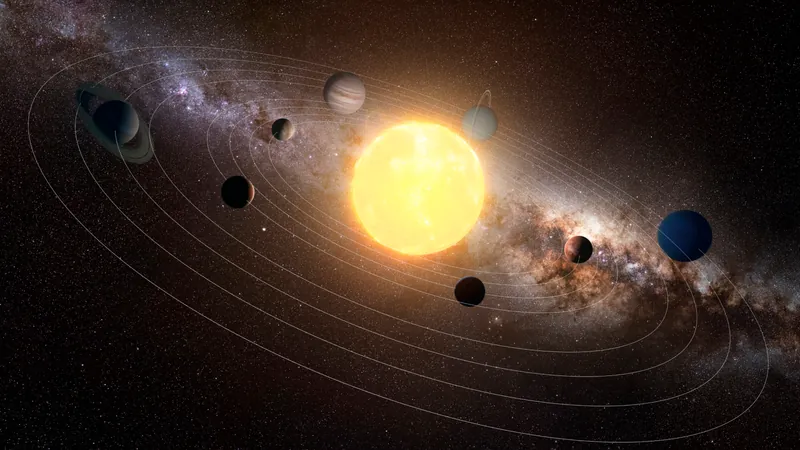
Did Earth, Mars, and a Lost Planet Once Dance in Celestial Harmony?
2025-08-02
Author: Yan
A Cosmic Dance of Planets Unveiled
In an astonishing revelation, a recent study suggests that Earth and three other terrestrial planets, including a mythical long-lost world, may have once orbited the sun in a synchronized celestial dance. This new insight indicates that these rocky planets could have formed much earlier than we had previously believed.
The Fascination with Planetary Configurations
Astronomers are increasingly captivated by how planetary systems evolve over cosmic timescales, particularly after discovering intriguing families of exoplanets, such as the seven planets circling the diminutive star TRAPPIST-1.
Research has established that an early stage in the life of a planetary system involves planets moving in rhythmic patterns—a phenomenon known as resonance—around their host star. In the case of TRAPPIST-1, for instance, the innermost planet completes eight orbits for every five completed by its neighboring body.
Resonance: A Dance of Orbits
Resonance occurs among planets formed within a protoplanetary disk, a swirling mass of debris surrounding a newly formed star. As these planets traverse the gas-rich environment, they exchange energy, often nudging them closer to their parent star, which allows their orbital periods to resonate.
Today, our solar system's planets do not exhibit resonance, although Venus and Mars exhibit a near-ratio of 3.05:1. Historically, however, studies in 2005 revealed that Jupiter and Saturn engaged in a resonant waltz during their formative years.
A Missing Piece of the Puzzle
Until now, scientists had not thoroughly explored whether Earth, Mars, and their companions had ever been caught in such a resonance. Chris Ormel, an associate professor from Tsinghua University and co-author of the study, noted that earlier theories focused on giant impacts as the dominant process for planet formation.
New Evidence Emerges
In 2013, research examining Martian isotopes hinted that terrestrial planets might have developed while the protoplanetary disk was still abundant in gas—roughly 10 million years post solar system formation, suggesting a time when resonance was indeed possible.
Creating a Cosmic Simulation
To explore this hypothesis, the study’s authors generated computer models of the infant solar system that included the gas giants Jupiter and Saturn alongside four rocky planets: Mars, Theia (a hypothesized planet-sized body whose collision with early Earth gave birth to our moon), early Earth, and Venus. Mercury was excluded due to its formation through giant impacts.
Simulations were designed by placing Saturn closer to Jupiter than its current position, modeling the growth of the rocky planets from pebbles and massive rock blocks. Remarkably, in many cases, Venus, Earth, Theia, and Mars formed a 2:3:4:6 resonant chain within the first million years.
Significant Findings and Implications
Out of 13,200 simulations spanning 100 million years, half reproduced the current arrangement of terrestrial planets, including the crucial collision of Theia with Earth and the orbital ratio of Venus and Mars—a remnant of their resonant past. This suggests that the planets formed significantly earlier, within a gas-rich protoplanetary disk, at least 20 million years prior to current models' predictions.
Venus: The Key to Understanding Our Origins
Venus could play a pivotal role in illuminating the age of the inner rocky worlds, as it has avoided the cataclysmic impacts that shaped Earth and Mars. Future missions might analyze Venus's mantle for clues about its ancient origins.
The Impact of Giant Planets
Additionally, this study illuminates how the gravitational influence of outer giant planets can drastically destabilize their inner counterparts, providing an explanation for the absence of giant planets in resonant systems like TRAPPIST-1.
These groundbreaking findings were published in The Astrophysical Journal on July 18, revealing new layers of complexity in our understanding of the solar system's history.



 Brasil (PT)
Brasil (PT)
 Canada (EN)
Canada (EN)
 Chile (ES)
Chile (ES)
 Česko (CS)
Česko (CS)
 대한민국 (KO)
대한민국 (KO)
 España (ES)
España (ES)
 France (FR)
France (FR)
 Hong Kong (EN)
Hong Kong (EN)
 Italia (IT)
Italia (IT)
 日本 (JA)
日本 (JA)
 Magyarország (HU)
Magyarország (HU)
 Norge (NO)
Norge (NO)
 Polska (PL)
Polska (PL)
 Schweiz (DE)
Schweiz (DE)
 Singapore (EN)
Singapore (EN)
 Sverige (SV)
Sverige (SV)
 Suomi (FI)
Suomi (FI)
 Türkiye (TR)
Türkiye (TR)
 الإمارات العربية المتحدة (AR)
الإمارات العربية المتحدة (AR)